Analytical Modeling and Optimization of a Heat Sink Design for Passive Cooling of Solar PV Panel
Abstract
:1. Introduction
2. Related Work
3. Experimental Setup
4. Materials and Methods
4.1. Problem Geometry and Description
- -
- The amount of solar irradiance is identical to all cells, which means no clouds in the sky or dust in the front surface.
- -
- Since the time response of the system is short, the heat flow is assumed to be steady.
- -
- The side walls are adiabatic.
- -
- Since the total thickness of the system is small compared to its length and width, the flow is one-dimensional.
4.2. Mathematical Formulation and Analytical Solution
4.2.1. Estimation of the Total Front Resistance
4.2.2. Estimation of the Total Back Resistance
4.2.3. Estimation of the Solar Panel Efficiency and Produced Power
5. Results and Discussion
5.1. Model Validation
5.2. Optimal Length of Fins
5.3. Impact of Ambient Temperature on Solar Panel Temperature
5.4. Impact of Tilt Angle on Panel Temperature for Different Fin Lengths and Thicknesses
5.5. Effect of Emissivity on Solar Panel Temperature at Different wind Speeds
5.6. Effect of Irradiance on Solar Panel Temperature at Different Emissivity Values
5.7. Effect of Fin Length on the Heat Flow Rejected from the Panel
6. Case Study: Dammam City
7. Conclusions
- Without cooling system, the majority of heat absorbed on the PV panel is rejected from the front side of the panel, and the panel temperature can exceed 90 °C in the harsh climate.
- With the proposed heat sink cooling with optimal fin length, the heat rejected from the backside is doubled, and the solar panel temperature cannot exceed 80 °C even at the worst possible weather conditions.
- At low values of wind velocity (dominant free convection), the surface radiation from the back surface is significant and can reduce the panel temperature by 12 °C. However, at high values of wind speed (forced convection mode), surface radiation effects can be neglected.
Author Contributions
Funding
Institutional Review Board Statement
Informed Consent Statement
Data Availability Statement
Conflicts of Interest
References
- Fu, R.; Feldman, D.J.; Margolis, R.M. US Solar Photovoltaic System Cost Benchmark: Q1 2018; National Renewable Energy Laboratory (NREL): Golden, CO, USA, 2018. [Google Scholar]
- Taylor, M.; Ralon, P.; Ilas, A. The Power to Change: Solar and Wind cost Reduction Potential to 2025; International Renewable Energy Agency (IRENA): Abu Dhabi, United Arab Emirates, 2016. [Google Scholar]
- Mustafa, R.J.; Gomaa, M.R.; Al-Dhaifallah, M.; Rezk, A.H. Environmental Impacts on the Performance of Solar Photovoltaic Systems. Sustain. J. Rec. 2020, 12, 608. [Google Scholar] [CrossRef] [Green Version]
- Vidyanandan, K. An overview of factors affecting the performance of solar PV systems. Energy Scan 2017, 27, 2–8. [Google Scholar]
- Zhang, X.; Shen, J.; Xu, P.; Zhao, X.; Xu, Y. Socio-economic performance of a novel solar photovoltaic/loop-heat-pipe heat pump water heating system in three different climatic regions. Appl. Energy 2014, 135, 20–34. [Google Scholar] [CrossRef]
- U.S. Department of Energy. Solar Energy Technology Basics. 2013. Available online: https://www.energy.gov/eere/solar/articles/solar-energy-technology-basics (accessed on 18 January 2021).
- Mah, O. Fundamentals of Photovoltaic Materials. National Solar Power Research Institute. Inc. Calif. 1998, 12, 21–98. [Google Scholar]
- Mussard, M.; Amara, M. Performance of solar photovoltaic modules under arid climatic conditions: A review. Sol. Energy 2018, 174, 409–421. [Google Scholar] [CrossRef]
- Wu, S.; Xiong, C. Passive cooling technology for photovoltaic panels for domestic houses. Int. J. Low-Carbon Technol. 2014, 9, 118–126. [Google Scholar] [CrossRef] [Green Version]
- Bhattacharya, T.; Chakraborty, A.K.; Pal, K. Effects of Ambient Temperature and Wind Speed on Performance of Monocrystalline Solar Photovoltaic Module in Tripura, India. J. Sol. Energy 2014, 2014, 817078. [Google Scholar] [CrossRef] [Green Version]
- Razak, A.; Irwan, Y.; Leow, W.; Irwanto, M.; Safwati, I.; Zhafarina, M. Investigation of the Effect Temperature on Photovoltaic (PV) Panel Output Performance. Int. J. Adv. Sci. Eng. Inf. Technol. 2016, 6, 682. [Google Scholar] [CrossRef]
- Ritzen, M.; Vroon, Z.; Rovers, R.; Geurts, C. Comparative performance assessment of a non-ventilated and ventilated BIPV rooftop configurations in the Netherlands. Sol. Energy 2017, 146, 389–400. [Google Scholar] [CrossRef]
- Dhimish, M.; AlRashidi, A. Photovoltaic Degradation Rate Affected by Different Weather Conditions: A Case Study Based on PV Systems in the UK and Australia. Electronics 2020, 9, 650. [Google Scholar] [CrossRef] [Green Version]
- Koteswararao, B.; Radha, K.; Vijay, P.; Raja, R. Experimental Analysis of solar panel efficiency with different modes of cooling. Int. J. Eng. Technol. (IJET) 2016, 8, 1451–1456. [Google Scholar]
- Al Harbi, Y.; Eugenio, N.; Al Zahrani, S. Photovoltaic-thermal solar energy experiment in Saudi Arabia. Renew. Energy 1998, 15, 483–486. [Google Scholar] [CrossRef]
- Hasanuzzaman, M.; Malek, A.; Islam, M.; Pandey, A.; Rahim, N. Global advancement of cooling technologies for PV systems: A review. Sol. Energy 2016, 137, 25–45. [Google Scholar] [CrossRef]
- Mazón-Hernández, R.; García-Cascales, J.; Vera-García, F.; Káiser, A.; Zamora, B. Improving the electrical parameters of a photovoltaic panel by means of an induced or forced air stream. Int. J. Photoenergy 2013, 2013, 830968. [Google Scholar] [CrossRef]
- Özkul, F.B.; Kayabasi, E.; Çelık, E.; Kurt, H.; Arcaklioğlu, E. Investigating the effects of cooling options on photovoltaic panel efficiency: State of the art and future plan. In Proceedings of the 2018 International Conference on Photovoltaic Science and Technologies (PVCon), Ankara, Turkey, 4–6 July 2018; IEEE: Piscataway, NJ, USA, 2018. [Google Scholar]
- Ahmad, N.; Khandakar, A.; El-Tayeb, A.; Benhmed, K.; Iqbal, A.; Touati, F. Novel Design for Thermal Management of PV Cells in Harsh Environmental Conditions. Energies 2018, 11, 3231. [Google Scholar] [CrossRef] [Green Version]
- Devaraj, R.; Mageshwaran, G.; Gokulachandran, R.; Mani, R. Experimental investigation on a hybrid solar collector to predict safe operating condition. Int. J. Ambient. Energy 2017, 40, 467–469. [Google Scholar] [CrossRef]
- Luo, Q.; Li, P.; Cai, L.; Chen, X.; Yan, H.; Zhu, H.; Zhai, P.; Li, P.; Zhang, Q. Experimental investigation on the heat dissipation performance of flared-fin heat sinks for concentration photovoltaic modules. Appl. Therm. Eng. 2019, 157, 113666. [Google Scholar] [CrossRef]
- Grubišić-Čabo, F.; Nižetić, S.; Čoko, D.; Kragić, I.M.; Papadopoulos, A. Experimental investigation of the passive cooled free-standing photovoltaic panel with fixed aluminum fins on the backside surface. J. Clean. Prod. 2018, 176, 119–129. [Google Scholar] [CrossRef]
- Grubišić-Čabo, F.; Nižetić, S.; Kragić, I.M.; Čoko, D. Further progress in the research of fin-based passive cooling technique for the free-standing silicon photovoltaic panels. Int. J. Energy Res. 2019, 43, 3475–3495. [Google Scholar] [CrossRef]
- Hasan, I.A. Enhancement the Performance of PV Panel by Using Fins as Heat Sink. Eng. Technol. J. 2018, 36, 798–805. [Google Scholar]
- Elsafi, A.; Gandhidasan, P. Performance of a Photovoltaic or Thermal Double-Pass Solar Air Heater with Different Fin Configurations. J. Clean Energy Technol. 2015, 3, 28–33. [Google Scholar] [CrossRef] [Green Version]
- Nehari, T.; Benlakam, M.; Nehari, D. Effect of the Fins Length for the Passive Cooling of the Photovoltaic Panels. Period. Polytech. Mech. Eng. 2016, 60, 89–95. [Google Scholar] [CrossRef] [Green Version]
- Popovici, C.G.; Hudişteanu, S.V.; Mateescu, T.D.; Cherecheş, N.-C. Efficiency Improvement of Photovoltaic Panels by Using Air Cooled Heat Sinks. Energy Procedia 2016, 85, 425–432. [Google Scholar] [CrossRef] [Green Version]
- Jakhrani, A.; Othman, A.; Rigit, A.; Samo, S. Comparison of solar photovoltaic module temperature models. World Appl. Sci. J. 2011, 14, 1–8. [Google Scholar]
- Ciulla, G.; Brano, V.L.; Moreci, E. Forecasting the Cell Temperature of PV Modules with an Adaptive System. Int. J. Photoenergy 2013, 2013, 192854. [Google Scholar] [CrossRef]
- Olukan, T.A.; Emziane, M. A Comparative Analysis of PV Module Temperature Models. Energy Procedia 2014, 62, 694–703. [Google Scholar] [CrossRef] [Green Version]
- Dubey, S.; Sarvaiya, J.N.; Seshadri, B. Temperature Dependent Photovoltaic (PV) Efficiency and Its Effect on PV Production in the World—A Review. Energy Procedia 2013, 33, 311–321. [Google Scholar] [CrossRef] [Green Version]
- Evans, D.; Florschuetz, L. Cost studies on terrestrial photovoltaic power systems with sunlight concentration. Sol. Energy 1977, 19, 255–262. [Google Scholar] [CrossRef]
- Weiss, L.; Amara, M.; Ménézo, C. Impact of radiative-heat transfer on photovoltaic module temperature. Prog. Photovolt. Res. Appl. 2016, 24, 12–27. [Google Scholar] [CrossRef]
- Singal, S.; Saini, R.; Raghuvanshi, C. Analysis for cost estimation of low head run-of-river small hydropower schemes. Energy Sustain. Dev. 2010, 14, 117–126. [Google Scholar] [CrossRef]
- Kaplani, E.; Kaplanis, S. Thermal modelling and experimental assessment of the dependence of PV module temperature on wind velocity and direction, module orientation and inclination. Sol. Energy 2014, 107, 443–460. [Google Scholar] [CrossRef] [Green Version]
- Álvarez, G.; Xamán, J.; Flores, J.; Alvarado, R. Nusselt Number for the Natural Convection and Surface Thermal Radiation in Solar Collectors. In Proceedings of the ISES World Congress 2007; Springer: Berlin/Heidelberg, Germany, 2008; Volumes I–V. [Google Scholar]
- Incropera, F.P.; Lavine, A.S.; Bergman, T.L.; DeWitt, D.P. Fundamentals of Heat and Mass Transfer; Wiley: New York, NY, USA, 2007. [Google Scholar]
- Arifin, Z.; Tjahjana, D.D.D.P.; Hadi, S.; Rachmanto, R.A.; Setyohandoko, G.; Sutanto, B. Numerical and Experimental Investigation of Air Cooling for Photovoltaic Panels Using Aluminum Heat Sinks. Int. J. Photoenergy 2020, 2020, 1574274. [Google Scholar] [CrossRef]
- Li, Z.; Ma, T.; Zhao, J.; Song, A.; Cheng, Y. Experimental study and performance analysis on solar photovoltaic panel integrated with phase change material. Energy 2019, 178, 471–486. [Google Scholar] [CrossRef]
- Bar-Cohen, A.; Rohsenow, W.M. Thermally Optimum Spacing of Vertical, Natural Convection Cooled, Parallel Plates. J. Heat Transf. 1984, 106, 116–123. [Google Scholar] [CrossRef]
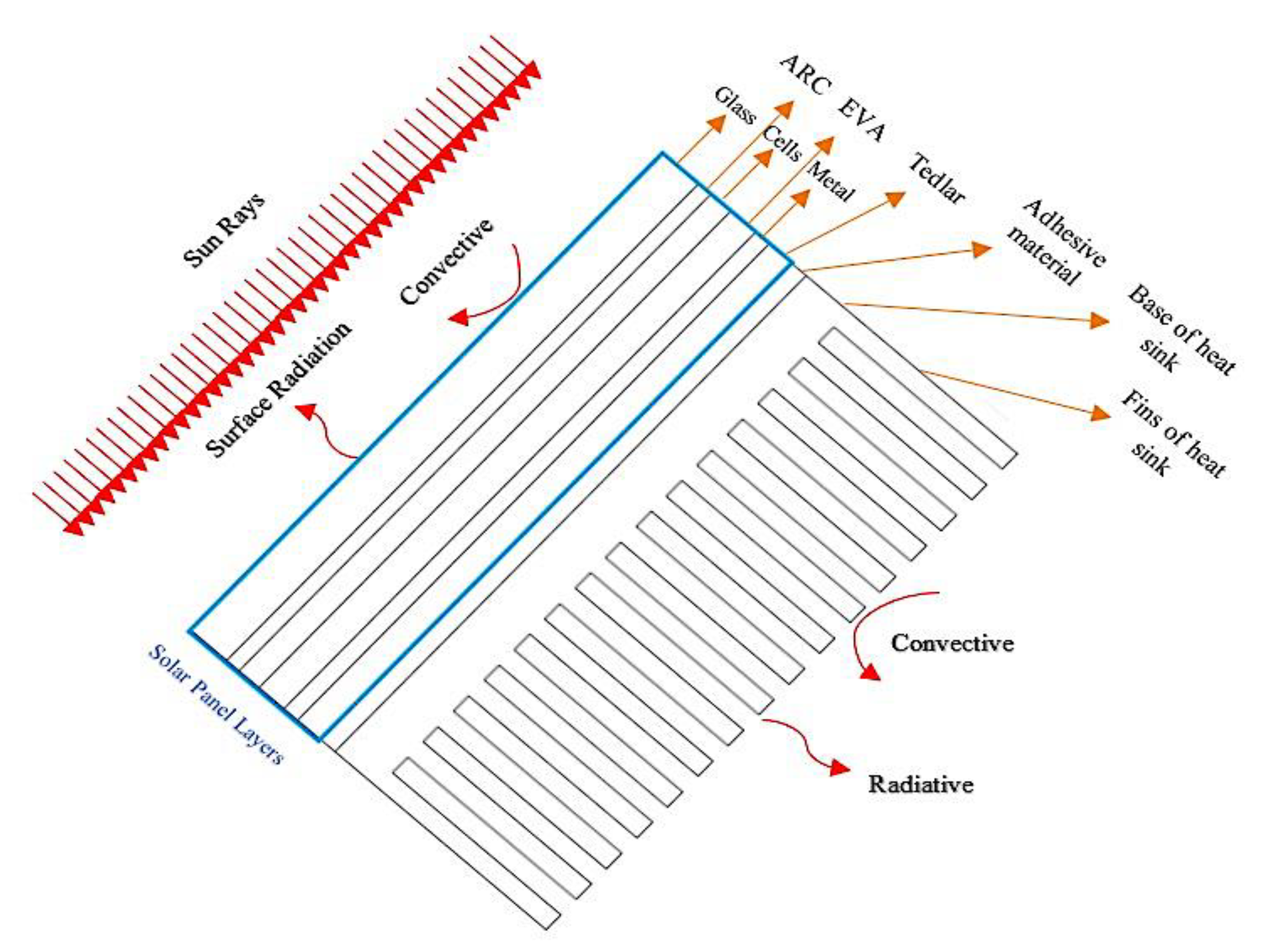

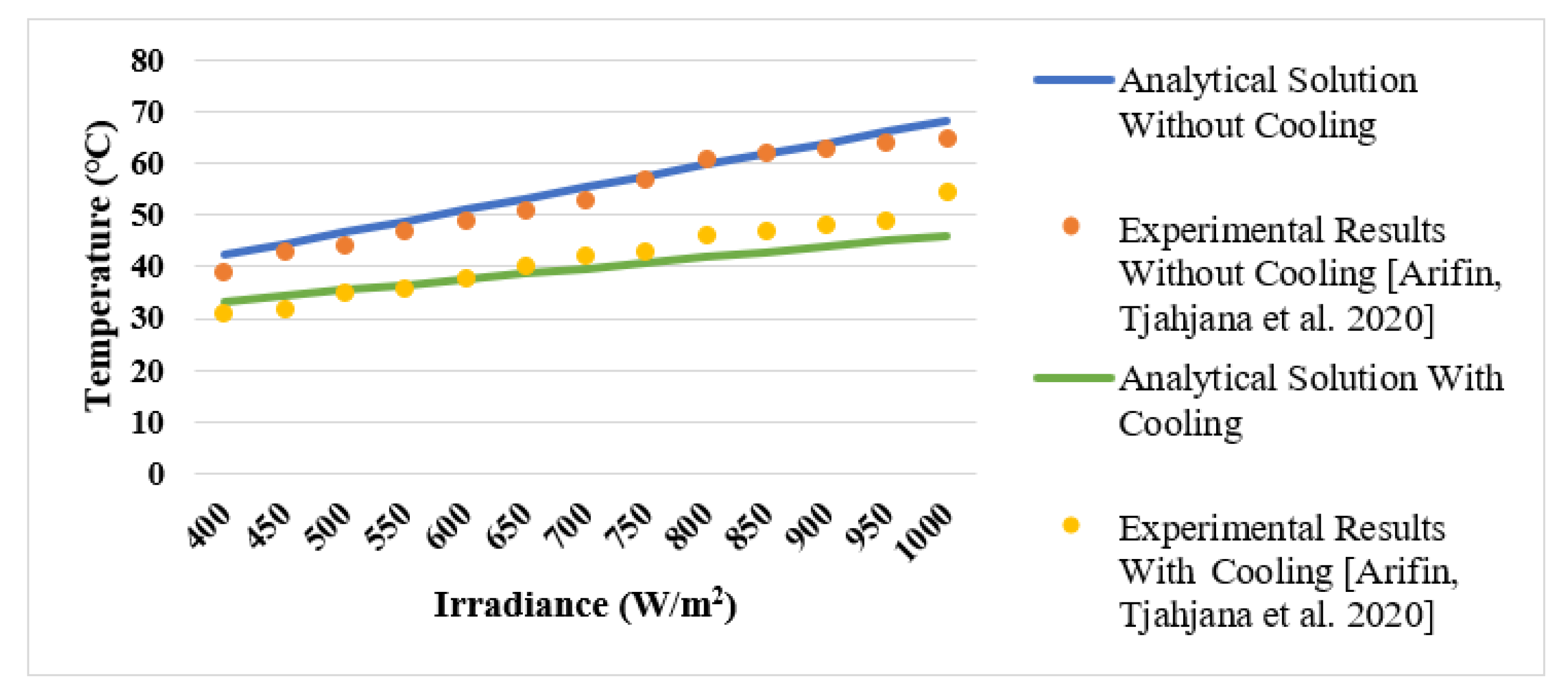

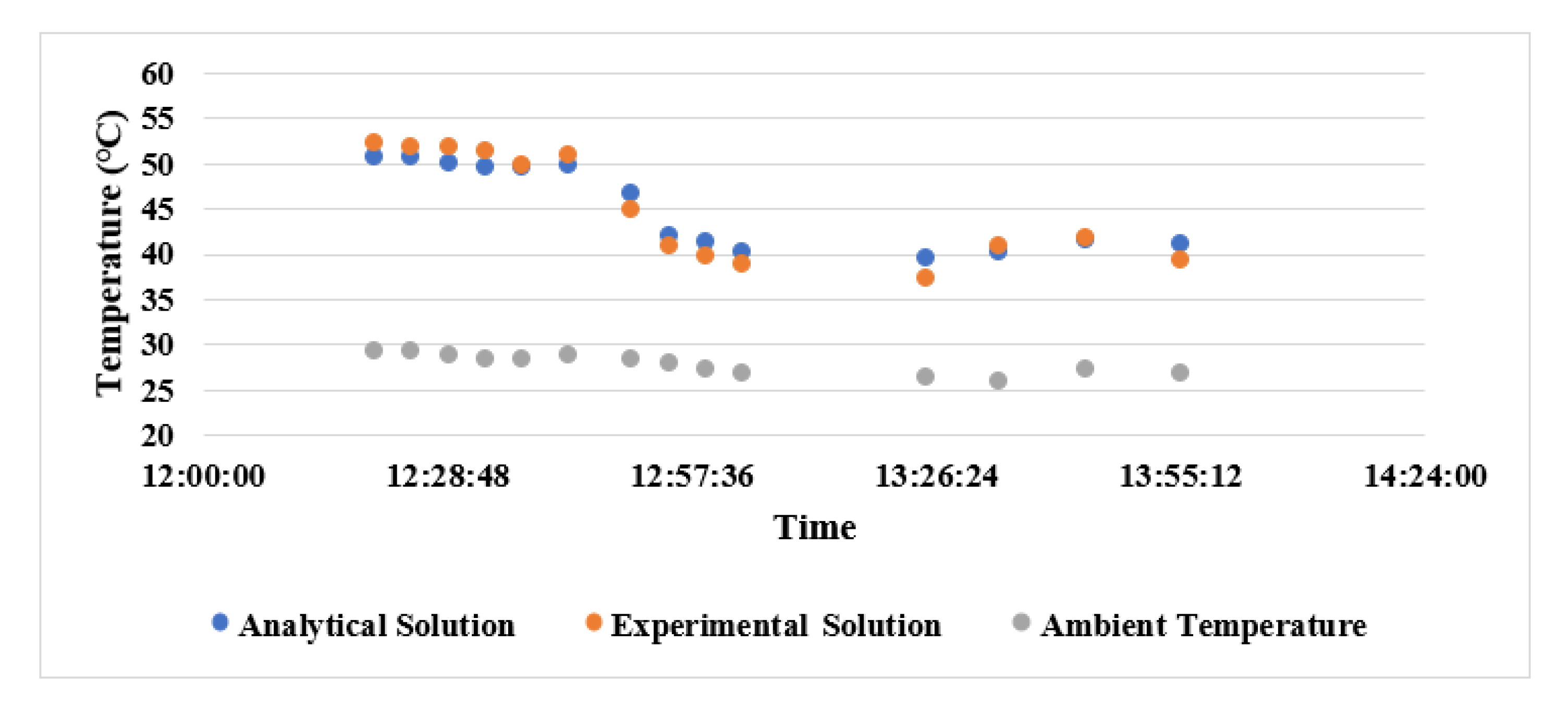

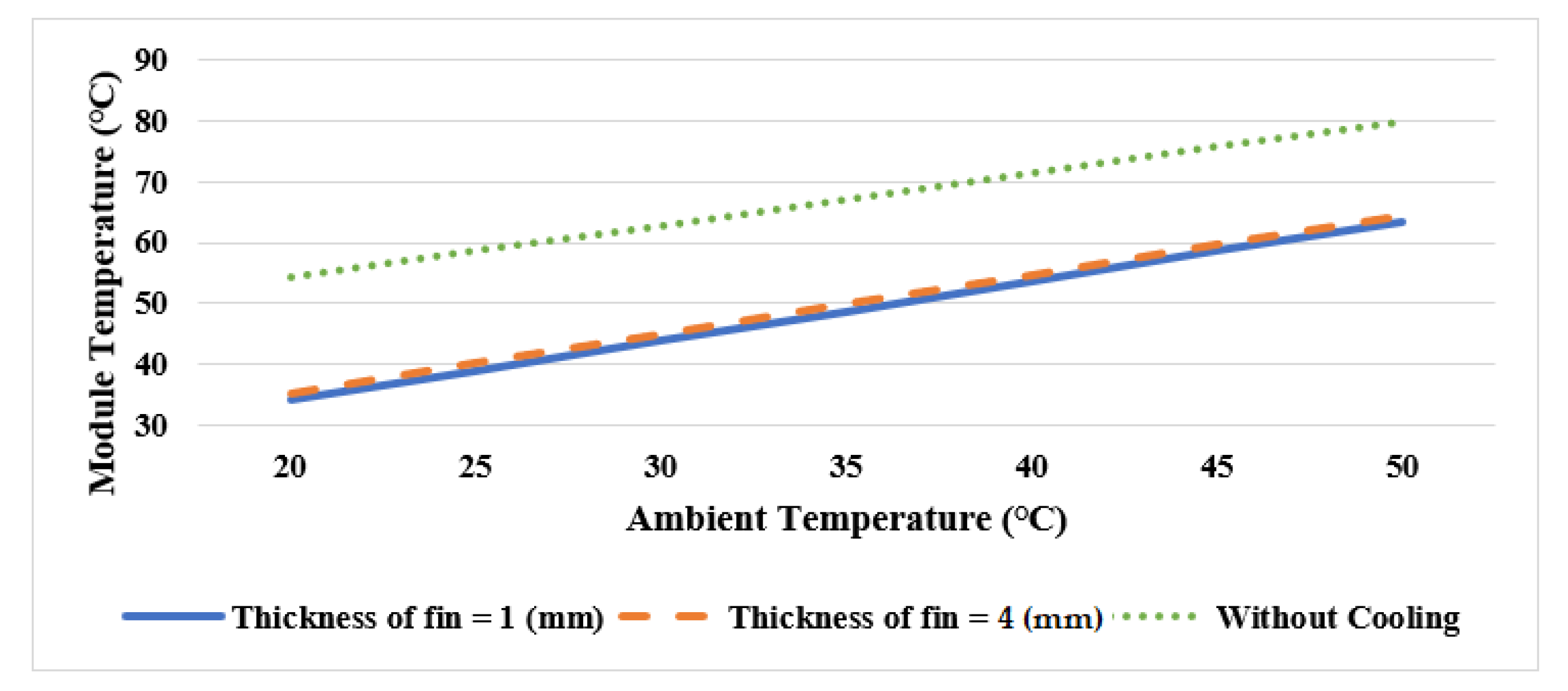
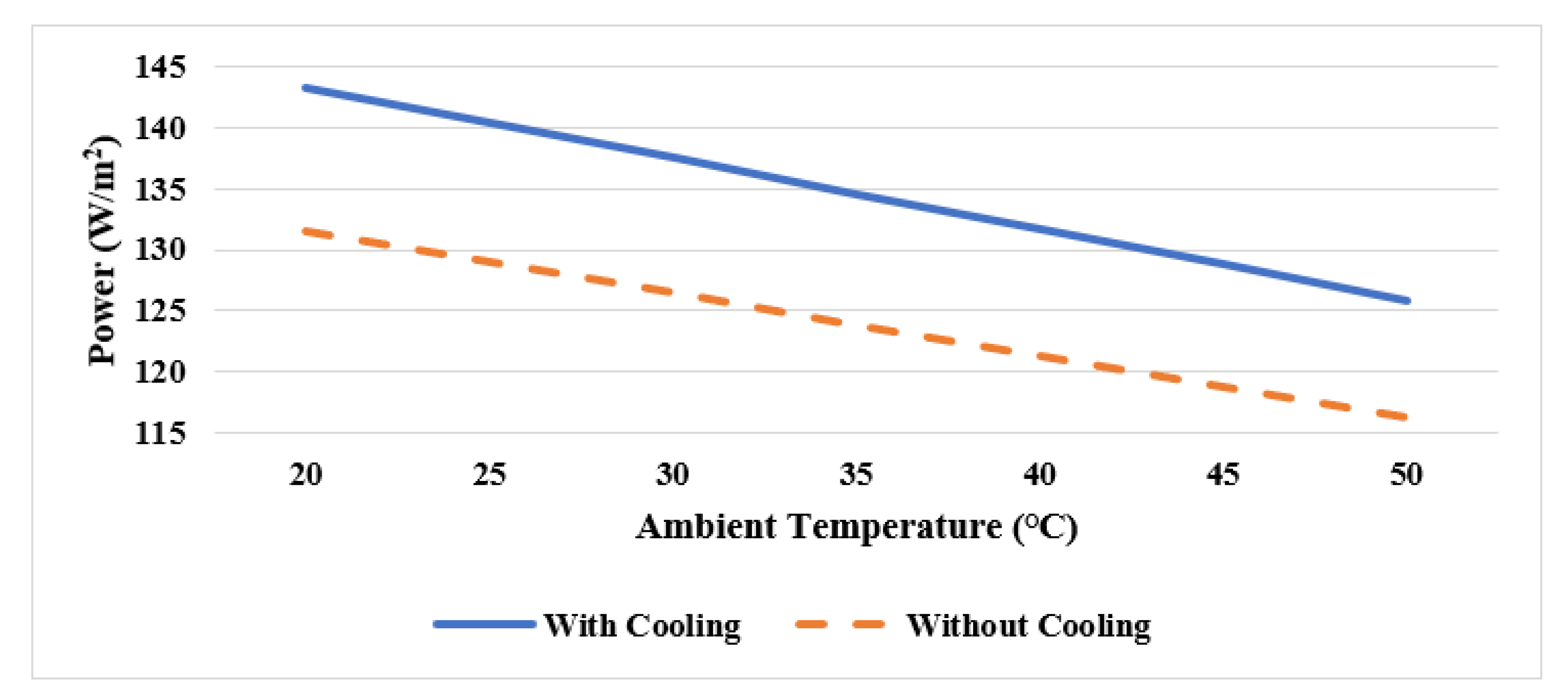
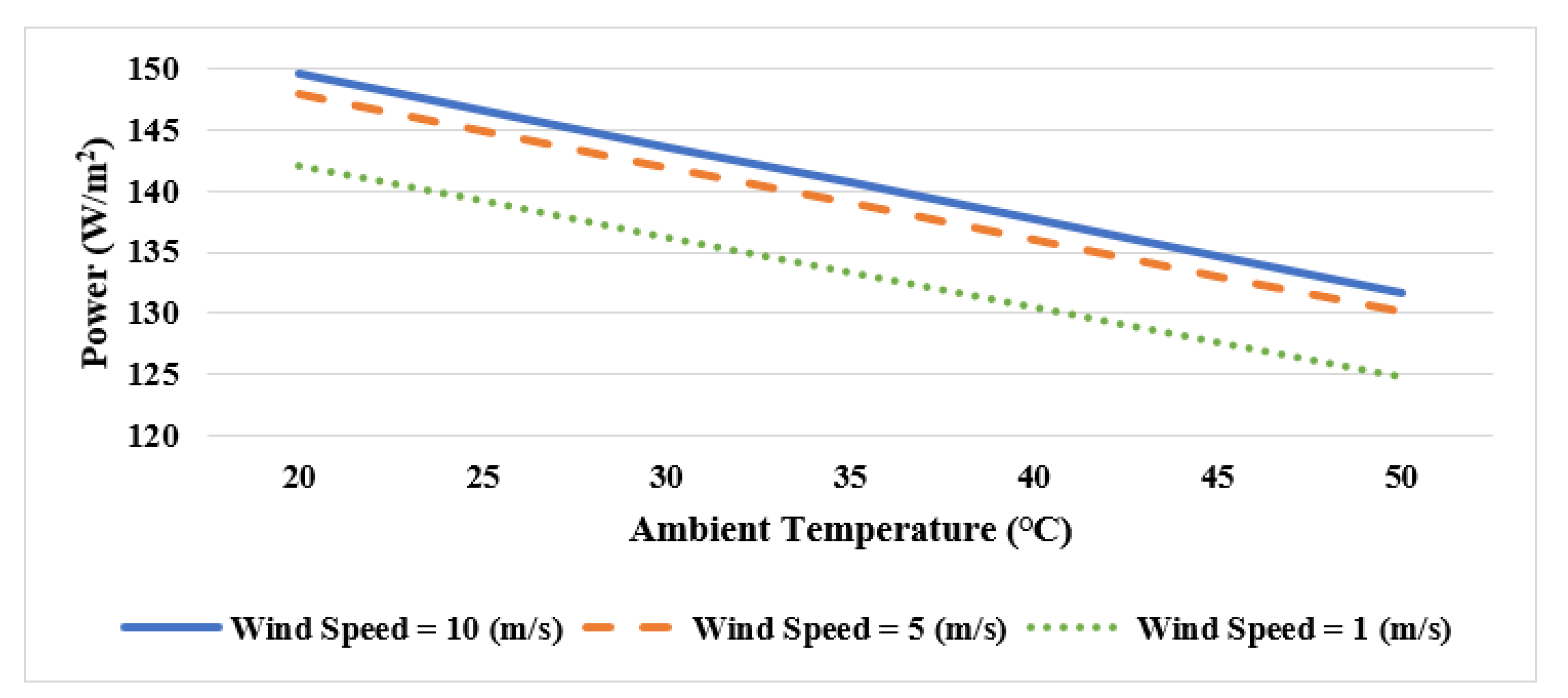
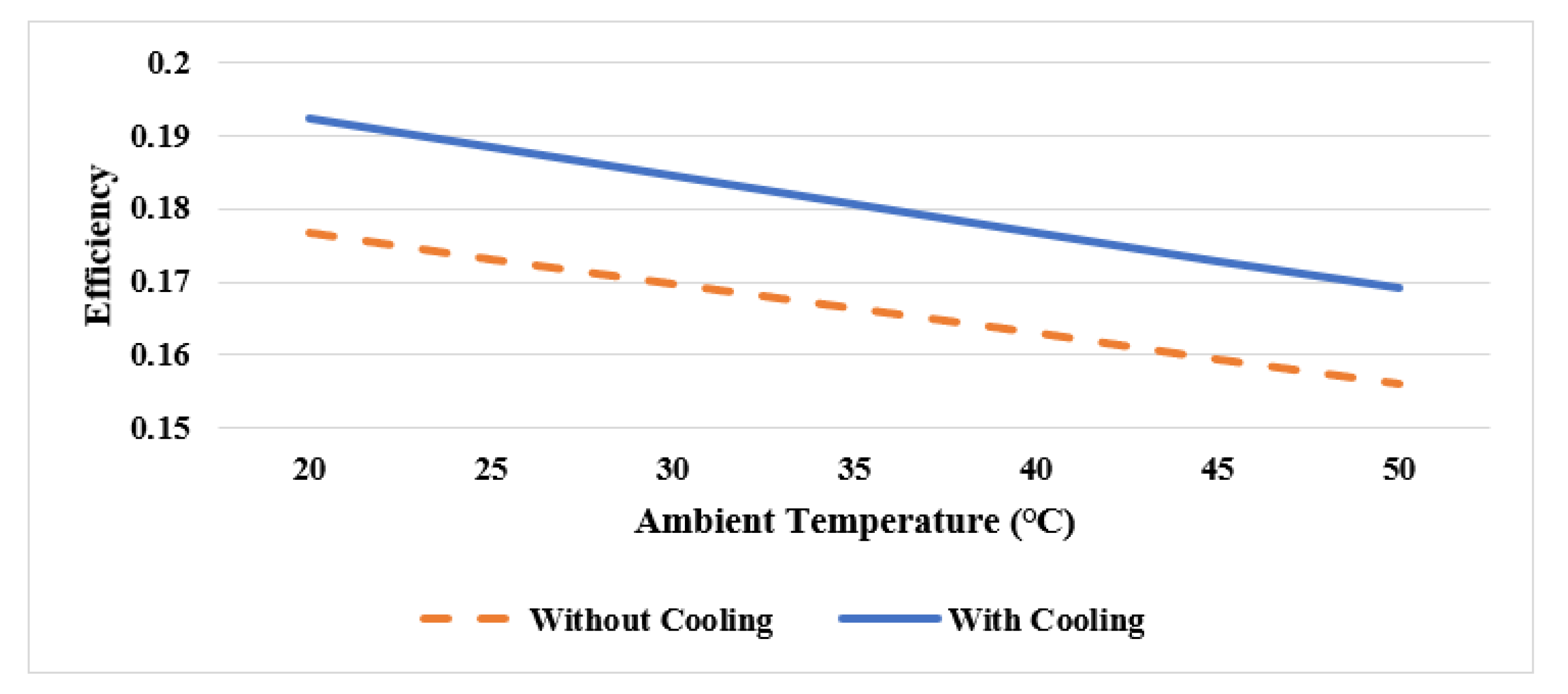

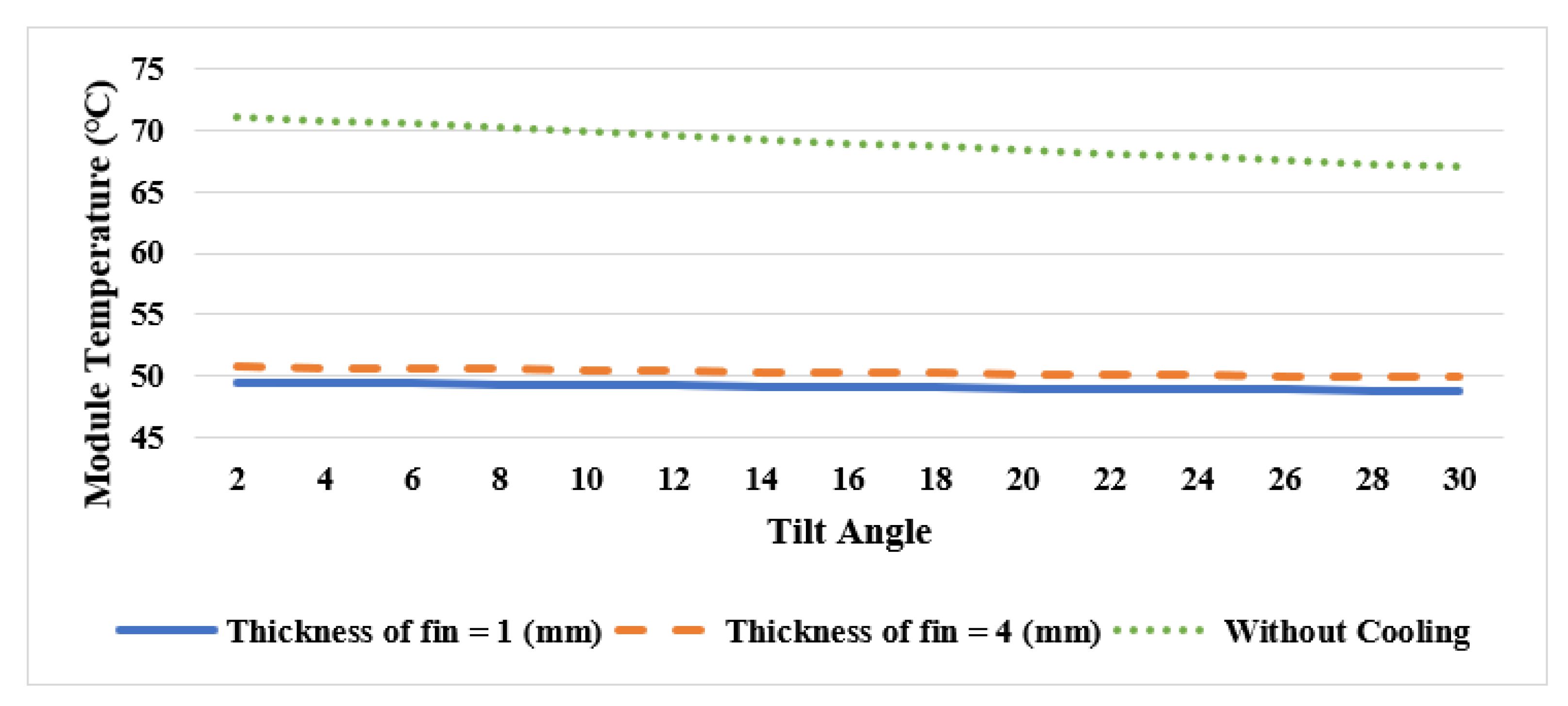
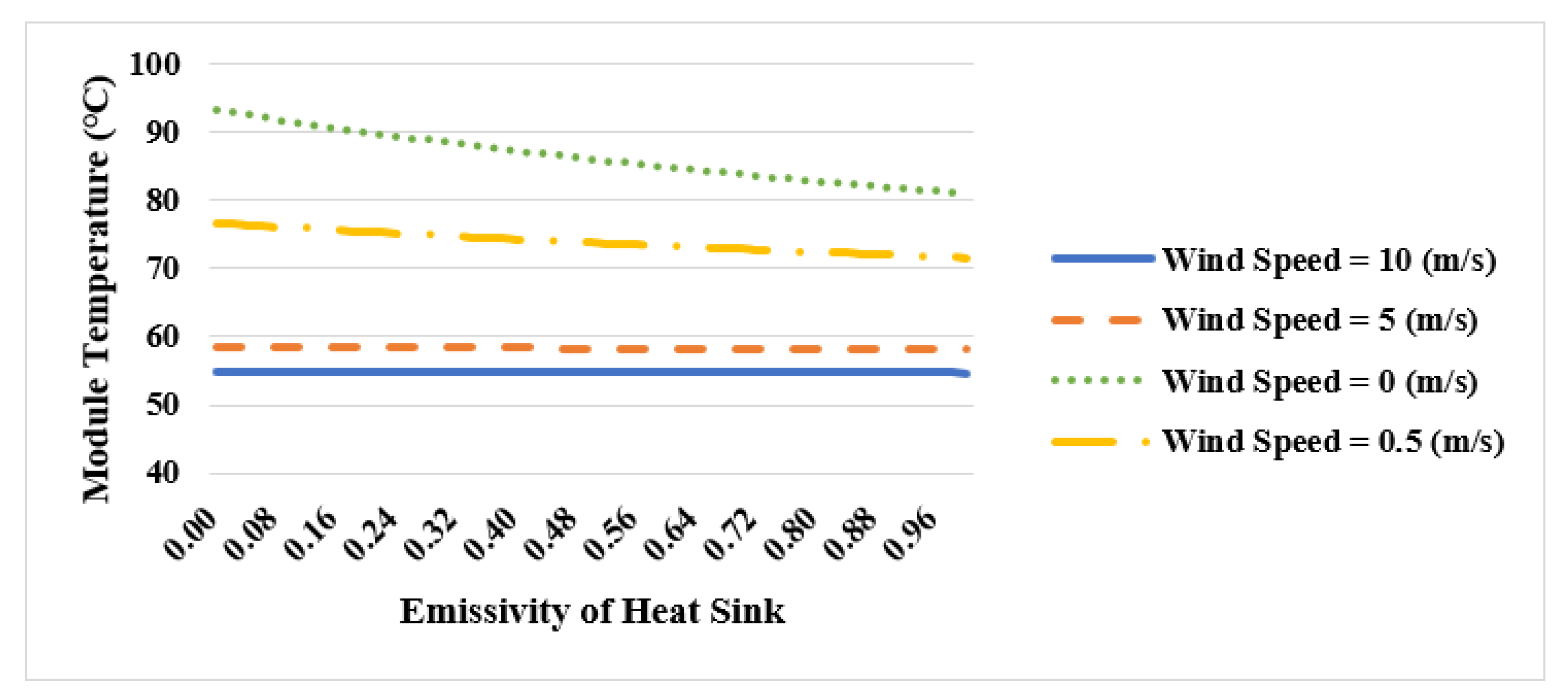

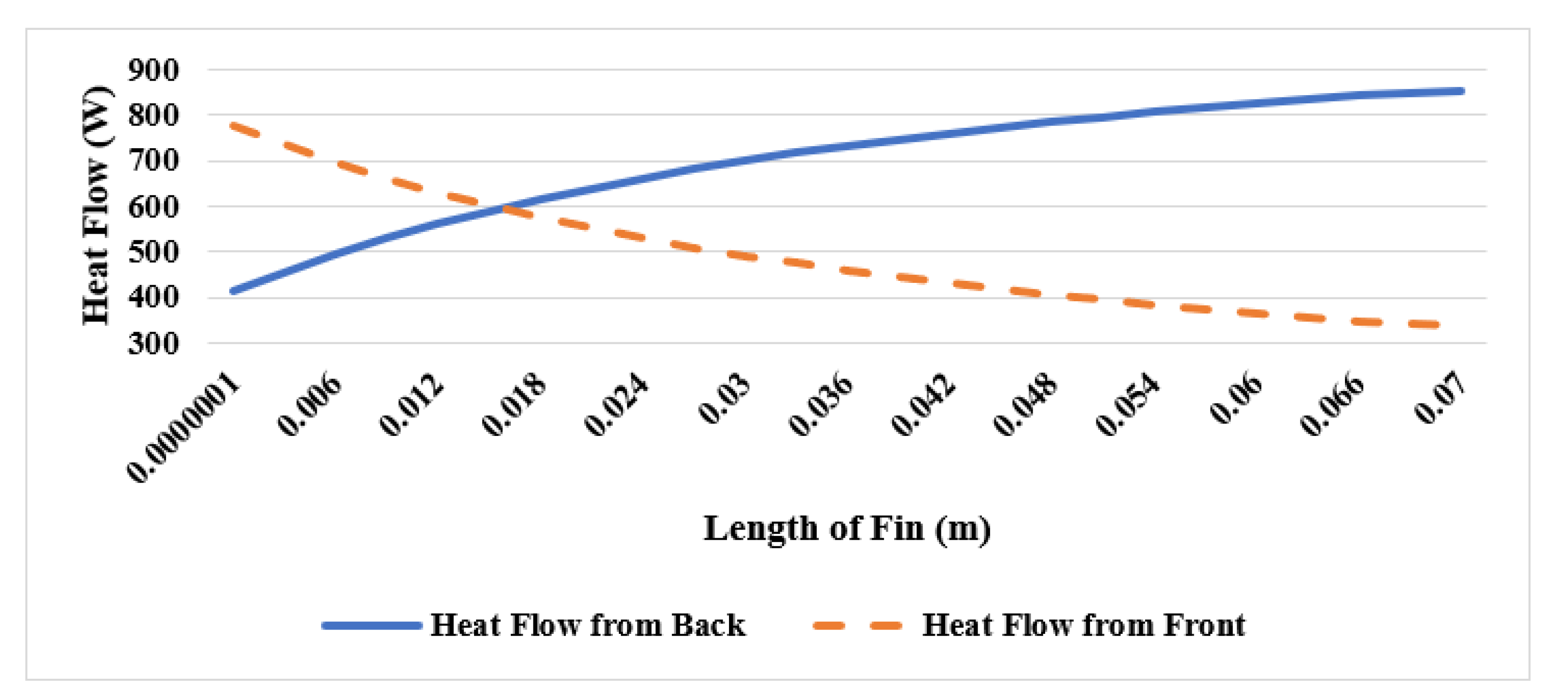

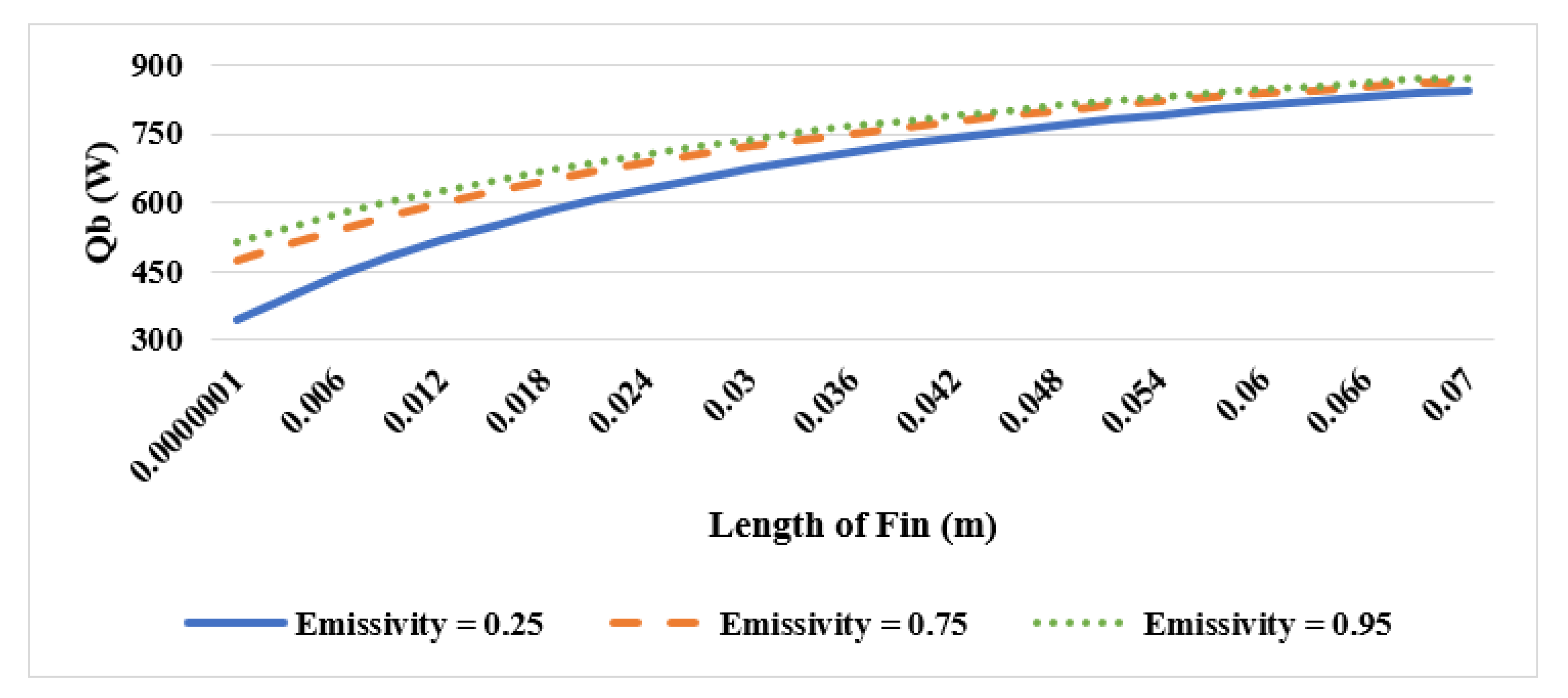
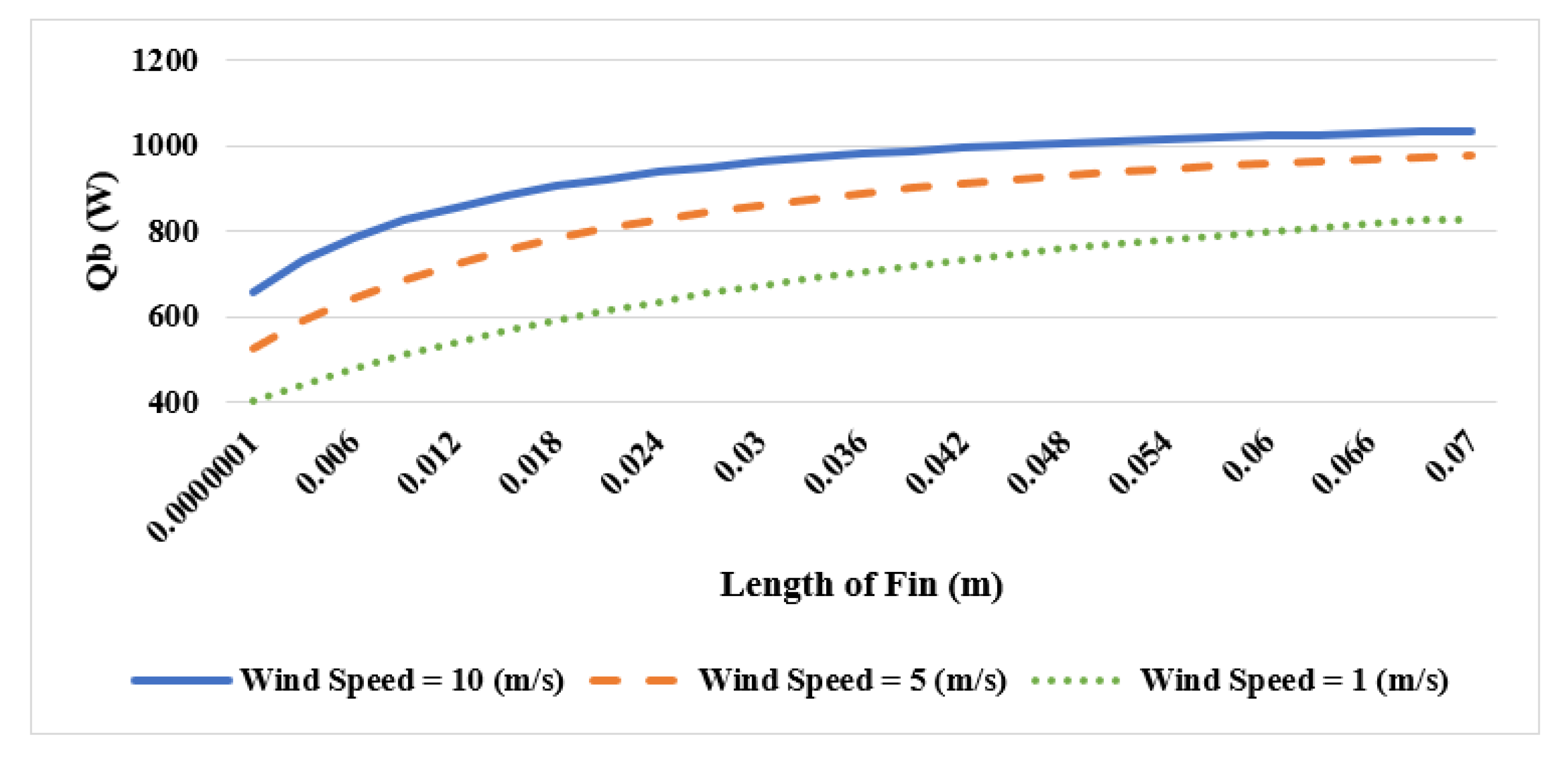
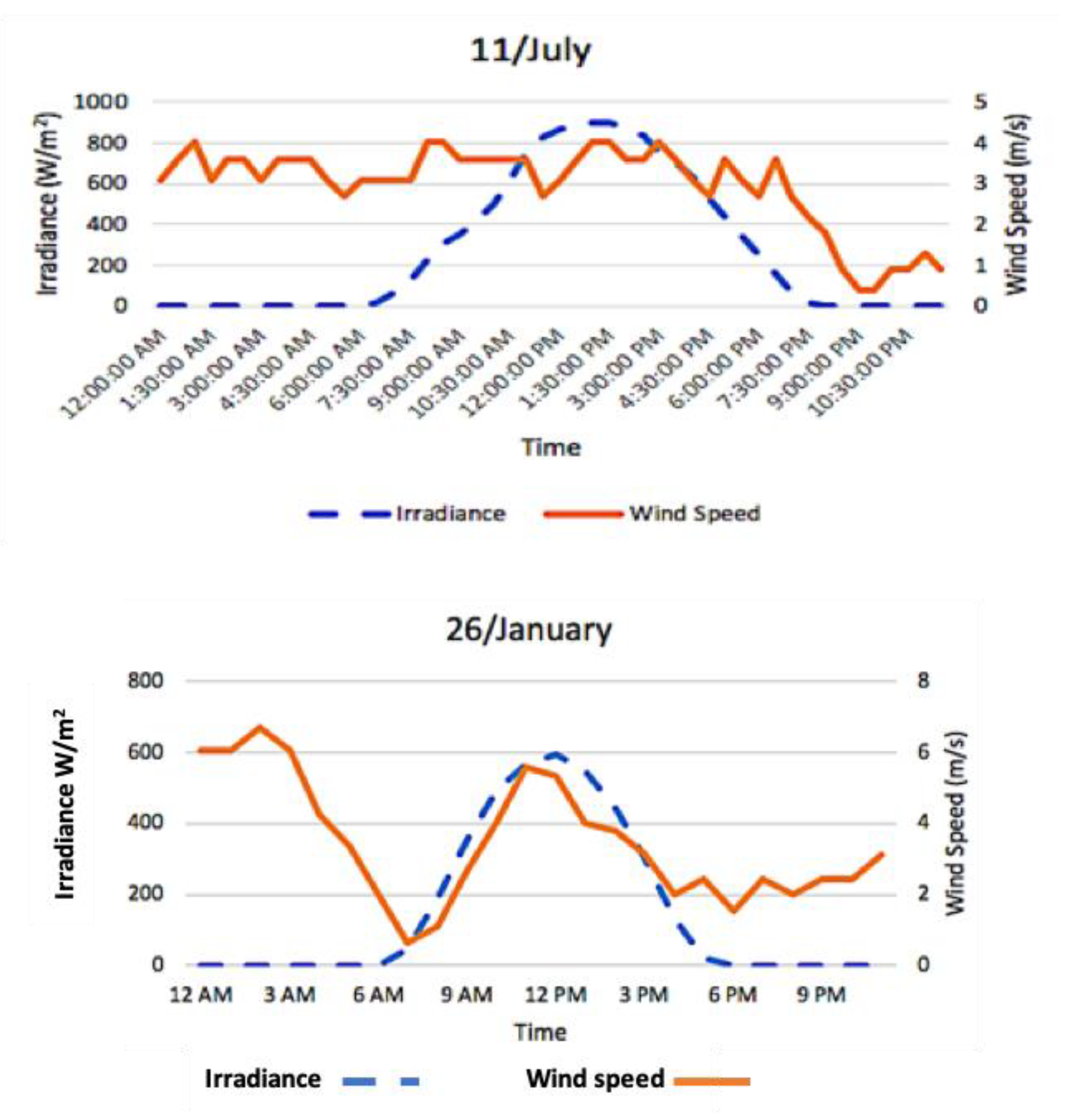
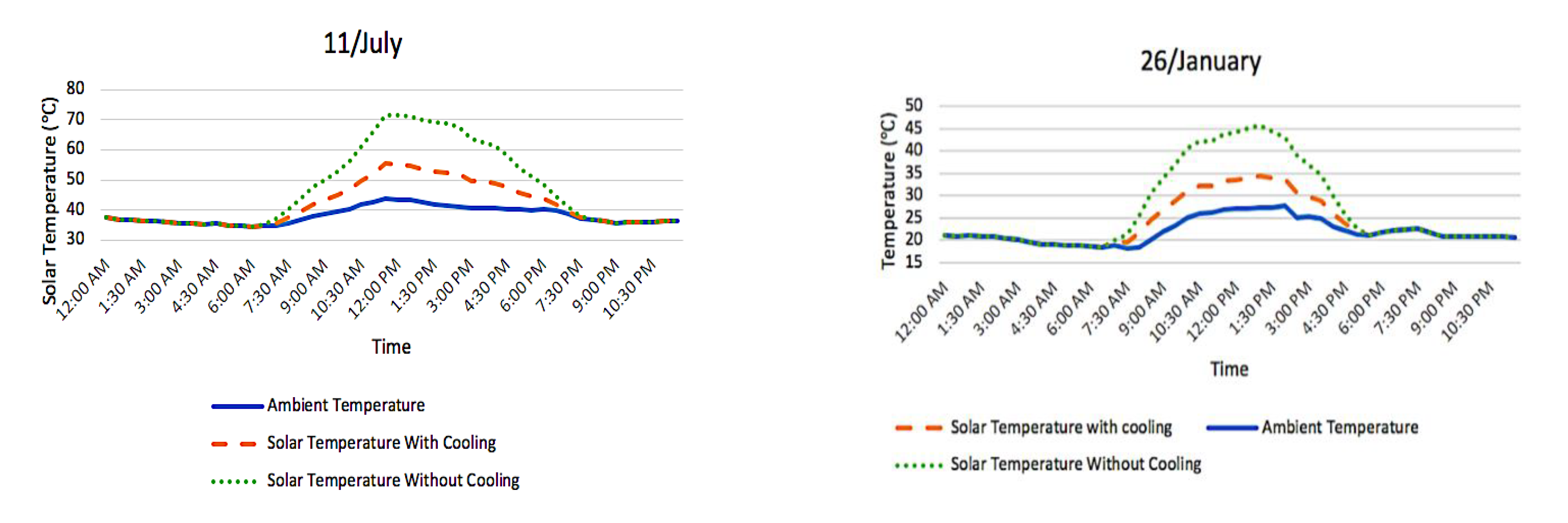

| Layer | Thickness (m) | Thermal Conductivity (W/m K) |
|---|---|---|
| Glass | 0.003 | 1.8 |
| ARC | 0.0000001 | 32 |
| PV cells | 0.000225 | 148 |
| EVA | 0.0005 | 0.35 |
| Rear contact | 0.00001 | 237 |
| Tedlar | 0.00001 | 0.2 |
| Adhesive material | 0.0001 | 1.5 |
| Heat sink | 0.0005 | 205 |
| Inputs Used by (Arifin, Tjahjana et al., 2020) [38] | Inputs Used by (Li, Ma et al., 2019) [39] | Inputs Used by (Ahmad, Khandakar et al., 2018) | |
|---|---|---|---|
| Width | 0.65 m | 1 m | 0.054 m |
| Length | 0.67 | 2 m | 1.19 m |
| Wind speed | 1.5 m/s | Real variable values | Real variable values |
| Irradiation | Real variable values | Real variable values | |
| Ambient temperature | 25 °C | Real variable values | Real variable values |
| Length of fin | 0.03 m | - | - |
| Thickness of fin | 0.002 m | - | - |
| RMSE | R2 | Chi-Square | Max Deviation | ||
|---|---|---|---|---|---|
| (Arifin, Tjahjana et al., 2020) [38] | Without cooling system | 1.46 | 0.97 | 0.99 | 8.58% |
| With cooling system | 3.76 | 0.69 | 0.98 | 15% | |
| (Li, Ma et al., 2019) [39] | Without cooling system | 2.13 | 0.97 | 0.99 | 7.47% |
| Ahmad, Khandakar et al., 2018) [19] | Without cooling system | 1.65 | 0.92 | 1 | 4.85% |
| Solar panel width | 1 m |
| Solar panel length | 2 m |
| Wind speed | 0 m/s |
| Recommended safe solar temperature | 80 °C |
| Irradiance | 1000 W/m2 |
| Ambient temperature | 50 °C |
| Thickness of fin | 0.001 m |
| Spacing between fins (optimal) | 0.015459 m |
| Emissivity of silicon | 0.85 |
| Emissivity of aluminum | 0.95 |
Publisher’s Note: MDPI stays neutral with regard to jurisdictional claims in published maps and institutional affiliations. |
© 2021 by the authors. Licensee MDPI, Basel, Switzerland. This article is an open access article distributed under the terms and conditions of the Creative Commons Attribution (CC BY) license (http://creativecommons.org/licenses/by/4.0/).
Share and Cite
AlAmri, F.; AlZohbi, G.; AlZahrani, M.; Aboulebdah, M. Analytical Modeling and Optimization of a Heat Sink Design for Passive Cooling of Solar PV Panel. Sustainability 2021, 13, 3490. https://doi.org/10.3390/su13063490
AlAmri F, AlZohbi G, AlZahrani M, Aboulebdah M. Analytical Modeling and Optimization of a Heat Sink Design for Passive Cooling of Solar PV Panel. Sustainability. 2021; 13(6):3490. https://doi.org/10.3390/su13063490
Chicago/Turabian StyleAlAmri, Fahad, Gaydaa AlZohbi, Mohammed AlZahrani, and Mohammed Aboulebdah. 2021. "Analytical Modeling and Optimization of a Heat Sink Design for Passive Cooling of Solar PV Panel" Sustainability 13, no. 6: 3490. https://doi.org/10.3390/su13063490






